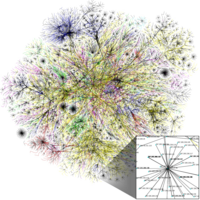
Photo from wikipedia
To improve the user experience, an extension of LTE/LTE-A over the unlicensed spectrum for both uplink and downlink called enhanced licensed-assisted access (eLAA) was introduced in release 14 standard. As… Click to show full abstract
To improve the user experience, an extension of LTE/LTE-A over the unlicensed spectrum for both uplink and downlink called enhanced licensed-assisted access (eLAA) was introduced in release 14 standard. As faced during the deployment of LAA, the unlicensed band is shared between different radio access terminals (RATs) (e.g., LAA, Wi-Fi, and radar) and one of the critical challenges reminds a fair coexistence with these technologies when LTE-A operates in the unlicensed band for uplink transmission. In this paper, we investigate a possible deployment of eLAA uplink based on scheduled access (SA) with self-carrier scheduling and random access (RA) schemes in coexistence with Wi-Fi. The proposed mathematical framework helps to model the spatiotemporal coexistence in RA and SA with different evaluation metrics. The analytical and numerical results show that eLAA uplink based on SA would make the design complex and impact more Wi-Fi than eLAA RA scheme. The control power function designed for LTE-A cell edge would impact the coexisting Wi-Fi severely while providing a nonsignificant improvement in the eLAA performance.
Journal Title: IEEE Access
Year Published: 2019
Link to full text (if available)
Share on Social Media: Sign Up to like & get
recommendations!